Free-surface
undulations in open channel flows: Undular jumps, Undular bores,
Standing waves
by Hubert CHANSON (h.chanson@uq.edu.au)
M.E., ENSHM Grenoble, INSTN, PhD (Cant.), DEng (Qld),
Eur.Ing., MIEAust., MIAHR, 13th
Arthur Ippen awardee
School of Civil Engrg., Univ. of Queensland, Brisbane QLD
4072, Australia
Presentation
In open channels, slow flow motion is called subcritical or fluvial flow
motion, while rapid flows are termed supercritical flows. For intermediate
conditions, the flow is said to be critical. Critical flow conditions
correspond to a singularity, where the flow depth and velocity are function
of the flow rate only, for a given cross-sectional shape. This singularity
is unstable and critical flow conditions cannot be sustained over a long
distance without the development of free-surface undulations.
Undulations are stationary standing waves and they are often observed in
hydraulics jumps and positive surges with low inflow Froude numbers.
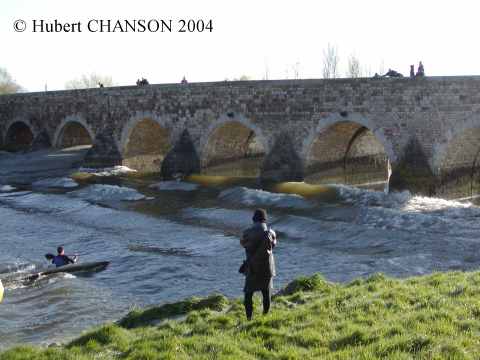 A hydraulic jump is a
stationary transition from a rapid (supercritical flow) to a slow flow
motion (subcritical flow). Although the hydraulic jump was described by
LEONARDO DA VINCI, the first experimental investigations were published by
Giorgio BIDONE in 1820. It is extremely turbulent and characterised by the
development of large-scale turbulence, surface waves and spray, energy
dissipation and air entrainment (e.g. CHANSON
and BRATTBERG 2000). The large-scale turbulence region is usually
called the 'roller'. Experimental observations highlight different types of
hydraulic jumps, depending upon the Froude number (footnote
(1)) of the upstream flow. An undular hydraulic jump is
observed at low Froude numbers (1< Fr <3): looking downstream (Fr=1.2)
and sideview (Fr=1.6) (CHANSON and MONTES
1995, MONTES and CHANSON 1998). With increasing Froude numbers, other types
of jumps include weak jump, oscillating jump (3.5< Fr <4.5), steady
jump and strong jump (Fr >10).
These photographs show surfers riding on a hydraulic jump roller in a river
in Munich, Germany (Photo No. 1 : flow
from right to left, Photo No. 2:
looking downstream, Courtesy of Dale YOUNG).
A hydraulic jump is a
stationary transition from a rapid (supercritical flow) to a slow flow
motion (subcritical flow). Although the hydraulic jump was described by
LEONARDO DA VINCI, the first experimental investigations were published by
Giorgio BIDONE in 1820. It is extremely turbulent and characterised by the
development of large-scale turbulence, surface waves and spray, energy
dissipation and air entrainment (e.g. CHANSON
and BRATTBERG 2000). The large-scale turbulence region is usually
called the 'roller'. Experimental observations highlight different types of
hydraulic jumps, depending upon the Froude number (footnote
(1)) of the upstream flow. An undular hydraulic jump is
observed at low Froude numbers (1< Fr <3): looking downstream (Fr=1.2)
and sideview (Fr=1.6) (CHANSON and MONTES
1995, MONTES and CHANSON 1998). With increasing Froude numbers, other types
of jumps include weak jump, oscillating jump (3.5< Fr <4.5), steady
jump and strong jump (Fr >10).
These photographs show surfers riding on a hydraulic jump roller in a river
in Munich, Germany (Photo No. 1 : flow
from right to left, Photo No. 2:
looking downstream, Courtesy of Dale YOUNG).
A surge in an open channel is a sudden change of flow depth (i.e. abrupt
increase or decrease in depth). An abrupt increase in flow depth is called a
positive surge while a sudden decrease in depth is termed a negative surge.
This picture shows an undular surge (Photo,
propagation from left to right). A positive surge looks like a moving
hydraulic jump. The application of the momentum principle to the unsteady
flow is based upon a quasi-steady flow situation analogy (CHANSON
1999, pp. 67-71, KOCH and CHANSON 2005). A bore is a positive surge of
tidal origin. Tidal bores occur as the tidal flow turns to rising (e.g. Lynch 1982) (Links : (1)
). Famous ones include the Hangchow (or Hangzhou) bore on the Qiantang
river, the Amazon bore called pororoca, the tidal
bore on the Seine river (mascaret), the Hoogly (or Hooghly)
bore on the Gange. Smaller tidal bores occur on the Severn river near
Gloucester, England, on the Trent river (aegir), on the Garonne and
Dordogne rivers, France, at Turnagain Arm and Knik Arm, Cook Inlet (Alaska),
the bores in the Bay of Fundy (New Brunswick, Nova Scotia) like at
Petitcodiac, tidal bores on the Styx river QLD and on the Daly river NT
(Australia), the tidal bore called benak at Batang Lupar (Malaysia).
The front of a positive surge absorbs random disturbances on both sides of
the surge and this makes the positive surge stable and self-perpetuating.
With appropriate boundary conditions, a tidal bore may travel long distances
upsteam of the river mouth. For example, the tidal bore on the Pungue river
(Mozambique) is still about 0.7 m high about 50 km upstream of the mouth and
it may reach 80 km inland.
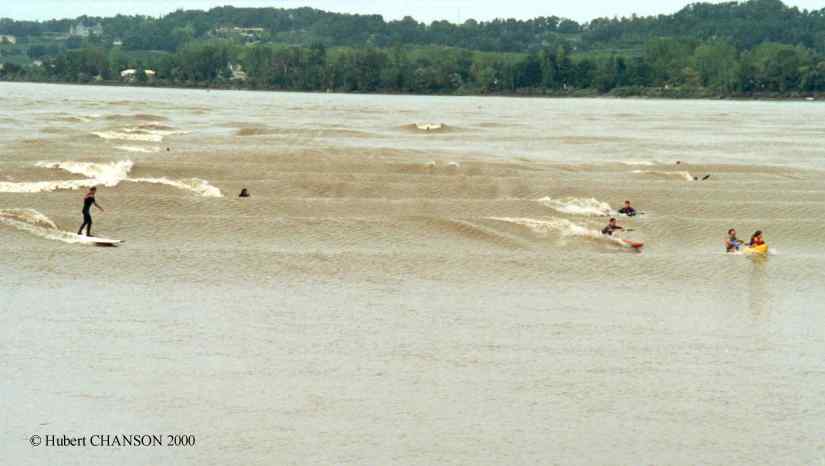 A personal experience of
undular tidal bores
A personal experience of
undular tidal bores
Hubert Chanson observed the undular tidal bore of the Dordogne river
on 27 Sept. 2000 (5:00pm) (CHANSON 2001, IAHR
Congress). The bore propagates first in the Gironde
before separating and continuing both in the Garonne and in the Dordogne (Map).
At
St Pardon, the tidal bore was an undular bore on the day. Photographs No. 1
and 3 illustrate the undular nature of the positive surge. Photo
No. 1 shows the arriving bore. Photo
No. 2 illustrates kayacks and surfers riding the bore. Photo
No. 3 was taken just downstream of St Pardon while Photo
No. 4 was shot in front of St Pardon.
On 7 April, the writer experienced the Sélune river tidal bore at
Roche-Torin and Pontaubault, about 90 min. and 30 min. respectively before
the high tide at Mont Saint-Michel. The tidal range was 13.75 m and it was
the largest tides in the Baie du Mont Saint Michel for 2004. At Roche-Torin,
the writer heard the rumble of the tidal bore about 25-30 min. before the
bore front arrived. The bore was first visible between Ile de Tombelaine and
Pointe du Grouin du Sud (Fig. 3A). The
front was more than one kilometre wide and it had not yet divided between
the Sée and Sélune river channels. Later the advancing front entered the
Sélune river mouth with a celerity of about 2.7 to 3.1 m/s (Fig.
3B). The freshwater flow was negligible and the advancing bore height
was about 0.3 to 0.6 m, although the bore constantly evolved in shape in
response of changes in channel topography. In front of Roche-Torin, the
middle section of the bore was an undular bore in the deep water channel,
while breaking bores were observed in the shallower waters and sometimes on
dry flats. At one stage, the undular bore disappeared briefly on the channel
centreline possibly because of a deeper water hole, although the breaking
bores were clearly seen elsewhere moving upstream of Roche-Torin. About 50
min. later, the tidal bore reached Pontaubault, about 8 km upstream of
Roche-Torin (Fig. 3C). A group of
kayackists was following the bore for a few kilometres. The bore celerity
was about 2.5 to 2.7 m/s, the freshwater flow velocity before bore arrival
was about 0.1 m/s while the advancing bore front was about 0.4 to 0.6 m
high. The bore then flowed beneath a 15th century stone bridge, called Pont
Aubaud. The bore passage between the piers was extremely turbulent. Note
that the bridge piers were shaped to cut the tidal bore.
Undular flows
When the flow Froude number ranged between 0.3 and 3, the relationship
between specific energy and flow depth shows that a small change in energy
can cause a large change in flow depth (CHANSON 1999,
pp. 31-46). The flow is unstable and it often characterised by the
development of free-surface undulations. The undulations are
stationary waves, fixed in time and space. They are sometimes called
improperly "standing waves" (footnote (2)).
When the flow Froude number is unity, the flow is said to be critical (i.e.
critical flow conditions). Flows with 0.3 < Fr < 3 are sometimes
called "near-critical flows". It was shown that the wave amplitude can reach
very large values depending upon the flow Froude number and aspect ratio.
These free-surface undulations might overtop and damage the channel banks.
The propagation of larges waves over very long distances might also disrupt
navigation, pump or turbine operation, induce unnecessary vibrations to
downstream structures (e.g. locks and gates) or disturb discharge
measurements at downstream discharge meter structures. The presence of
undular flow modifies considerably the flow field and hence the turbulent
mixing in the channel. (Existing softwares and numerical models of turbulent
mixing and transport should not be used for undular jump flows.)
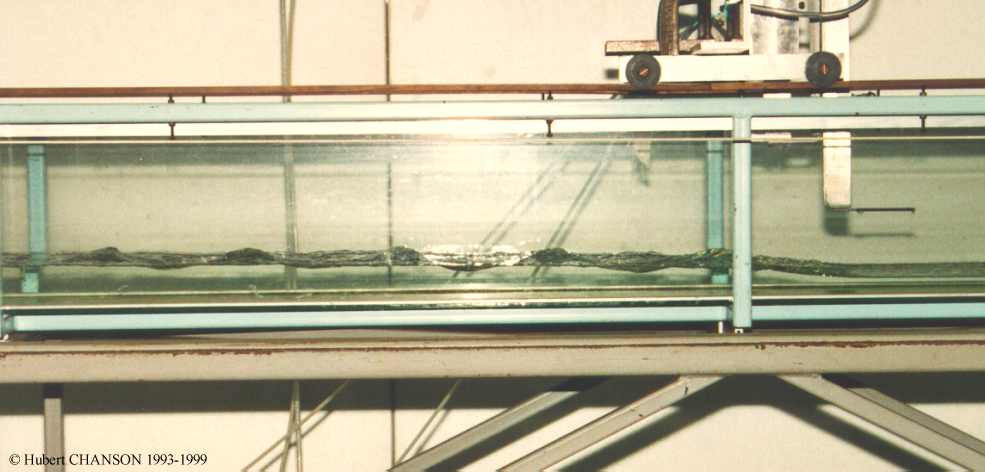 Basic experiments (CHANSON
1995) highlighted key features of undular flows in rectangular
channels:
Basic experiments (CHANSON
1995) highlighted key features of undular flows in rectangular
channels:
1. The vertical pressure distribution is not hydrostatic beneath the
free-surface undulations. The pressure gradient is larger than hydrostatic
at each wave trough and smaller at each wave crest. This observation is
consistent with the curvature of the free-surface and ideal fluid flow
considerations.
2. Significant velocity redistributions are observed between crest and
trough. Zones of flow recirculation are sometimes observed.
3. Undular flows may be greatly affected by small changes in boundary
friction. For example, for identical upstream Froude number and aspect
ratio, a modification of sidewall roughness modifies substantially the shape
and properties of the undular hydraulic jumps (CHANSON
2000, WRR).
4. The flow characteristics are significantly affected by the inflow
conditions (fully-developed or partially-developed) and by the aspect ratio
defined as the ratio of the channel width to the critical depth.
Summary
Free-surface undulations, undular jumps, undular surges and bores are
indications that the flow conditions are unstable : i.e., near-critical or
trans-critical. The stationary nature of the undulations is an impressive
feature, sometimes used by individuals to surf tidal bore front over long
distance.
The presence of free-surface undulations affect significantly the flow
field. Significant velocity and pressure field redistributions are observed
between successive crest and trough. In practice, undular flow conditions
must be avoided in hydraulic design and river engineering.
Footnotes
(1) Froude Number
The Froude number is proportional to the square root of
the ratio of the inertial forces over the weight of fluid. The Froude number
is used generally for scaling free surface flows, open channels and
hydraulic structures. Although the dimensionless number was named after
William FROUDE, several French researchers used it before. DUPUIT (1848) and
BRESSE (1860) highlighted the significance of the number to differentiate
the open channel flow regimes. BAZIN (1865a) confirmed experimentally the
findings. Ferdinand REECH introduced the dimensionless number for testing
ships and propellers in 1852. The number is called the Reech-Froude number
in France (CHANSON 1999, pp. 39-46). In
rectangular channels, the Froude number is commonly defined as the ratio of
the flow velocity to the square root of the product of g times d, where d is
the flow depth and g is the gravity acceleration (g = 9.80 m/s2 in
Brisbane).
(2) The term is "standing wave" is used for different meanings in ocean
engineering, river engineering and hydraulic design. Stationary "waves"
should be called free-surface undulations.
 Detailed
photographs
Detailed
photographs
Series No. 1 : Undular hydraulic
jump looking downstream (Fr=1.2) and
sideview (Fr=1.6) (H. CHANSON Apr. 1993)
Series No. 2 : "Mascaret" on the
Dordogne river, at Vayres (au port de St Pardon, France) : looking
in the bore direction, looking
upstream (Courtesy of Fabrice COLAS). The tidal bore (mascaret) on the
27 Sept. 2000 : Photo
No. 1 : arriving bore; Photo No. 2
: kayacks and surfers; Photo No. 3 :
close to St Pardon; Photo No. 4 : in
front of St Pardon. Tidal bore on the Dordogne river on 21
Feb. 2004 : Photo No. 1 :
arriving bore (surge Froude number about 1.05 to 1.1) at St Pardon; Photo
No. 2 : bore moving upstream towards Vayres. Photo
No. 3 : fisherman catching lamproie fish with net few minutes prior
the bore arrival between Vayres and St Pardon. Tidal bore of the
Dordogne river on 4 July 2008 : Photo No. 1 : view from Saint Pardon :
very weak undular surge. Photo No. 2 :
looking upstream towards Vayres. Menhir de
Pierrefitte : neolithic mounument located at Chateau Saint Martial, on
the right bank next to the old Pierrefitte harbour which serviced Saint
Emilion up the 16th century. Tidal bore on 20
July 2008 at sunrise : Photo No. 1
: Dordogne river in front of Port de Saint Pardon before the tidal bore
arrival. Photo No. 2 : ripple in the
channel centreline marking the tidal bore front, view from the left bank. Photo No. 3 : wave breaking next to the
left bank. Photo No. 4 : whelps 60
seconds after the tidal bore front passage. Tidal bore on 21
July
2008 at sunrise : Photo No. 1
: tidal bore front approching the jetty of Saint Pardon at 07:03. Photo
No. 2 : wave breaking at the jetty during the wave front passage. Photo No. 3 : wave breaking on the jetty
about 58 s after the tidal bore front passage. Tidal bore on 2
September 2008 evening : Photo No.
1: View from Port de Saint Pardon, looking downstream. Photo
No. 2 : surfers in front of Port de Saint Pardon. Photo
No. 3 : surfers on the second wave crest passing in front of Port de
Saint Pardon.
Series No. 3 : Severn river tidal
bore (England) : Photo No. 1 : at Awre
where the estuary is wide and shallow (Courtesy of Professor D.H.
PEREGRINE). The tidal bore is a breaking bore advancing from right to left.
Series No. 4 : Tidal
bore of the Daly river, Northern Territory, Australia.
Photograph taken late in 2000 when the water flow is lowest (Courtesy of
Gary Higgins, The Mango Farm). Note the flat undulations.
Series No. 5 : Tidal bore of the Sélune river, Baie du Mont
Saint Michel (France). Tidal bore on 7
April 2004 : tidal range = 13.75 m (highest tidal range for 2004).
Photo No. 1 : Sélune river estuary,
viewed from left bank at Roche-Torin at sunrise on 7/4/04 beofre tidal bore
arrival. Photo No. 2 : tidal bore seen
from Roche-Torin far away in front of Ile de Tombelaine with seagulls (white
dots) in front of the bore. Photo No. 3
: advancing tidal bore in front of Pointe du Grouin du Sud. Photo
No.
4 : advancing bore front viewed from Roche-Torin on 7/4/04. Photo
No. 5 : advancing bore front viewed from Roche-Torin on 7/4/04. Photo
No. 6 : advancing bore front just in front of Roche-Torin on 7/4/04. Photo No. 7 : tidal bore advancing
upstream, seen from Roche-Torin on 7/4/04. Photo
No. 8 : approaching tidal bore, one hour later, upstream of Pont
Aubaud (15th century bridge) at Pontaubault on7/4/04. Photo
No. 9 : approaching tidal bore, one hour later, upstream of Pont
Aubaud (15th century bridge) at Pontaubault on7/4/04. Photo
No.
10 : Sélune river tidal bore approaching Pont Aubaud (15th century
bridge) at Pontaubault on7/4/04. Photo No.
11 : Sélune river tidal bore passing below Pont Aubaud (15th century
bridge) at Pontaubault on7/4/04; note the bridge pier "knife" shape; note
also that the bore became an undular bore just downstream of the bridge,
possibly because of a local scour hole. Photo
No. 12 : strong current below Pont Aubaud (15th century bridge) on
7/4/04 after the tidal bore passage, view from left bank looking upstream.
Tidal bore on 2 August 2008: tidal
range = 12.65 m. Photo No. 1 : Sélune
river tidal bore at Roche Torin on 2/8/08 at sunset, viewed from the left
bank (bore propagation from left to right). Photo
No. 2 : tidal bore propagation past Roche Torin on 2/8/08. Photo
No. 3 : tidal bore past Roche Torin on 2/8/08. Photo
No. 4 : Sélune river tidal bore at Pontaubault on 2/8/08 at sunset,
about 1 hour after flowing past Roche Torin. Photo
No. 5 : Sélune river tidal bore at Pontaubault on 2/8/08, approaching
the histoical Pont Aubaud (15th century bridge); note the undular nature of
the tidal bore and the whelps (éteules). Photo
No. 6 : interactions of the whelps (éteules) with the bridge piers
shortly after the tidal bore front passage on 2/8/08. Tidal bore on 3
August 2008: tidal range = 12.65 m. Photo
No. 1 : Sélune river tidal bore at Roche Torin on 3/8/08 shortly after
sunrise, viewed from the left bank (bore propagation from left to right). Photo No. 2 : tidal bore propagation at
Roche Torin on 3/8/08.
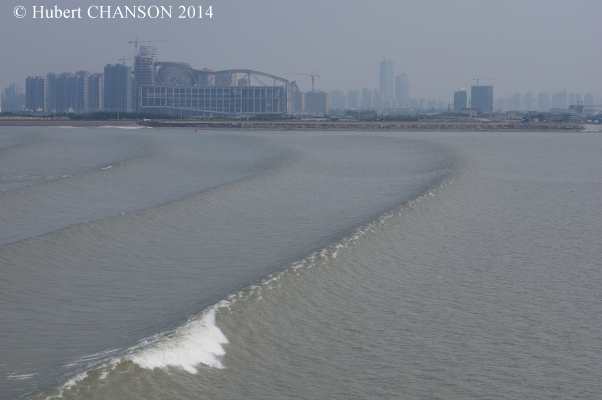 Read Coastal
Observations:
The Tidal Bore of the Sélune River, Baie du Mont Saint Michel, France
(Shore & Beach, 2004, Vol. 72,
No. 4, pp. 14-16).
Read Coastal
Observations:
The Tidal Bore of the Sélune River, Baie du Mont Saint Michel, France
(Shore & Beach, 2004, Vol. 72,
No. 4, pp. 14-16).
Series No. 6 : Tidal
bore of the Garonne river, France. Tidal bore on 5
July 2008 at Arcins (Latresnes). Photo
No. 1 : tidal bore entering the Arcins channel. Photo
No. 2 : incoming undular bore in the Arcins channel around 6:20am
looking downstream. Photo No. 3 :
whelps (eteules) behind the bore front shaking the pontoon and jetty. Tidal
bore on 5 July 2008 at Langoiran. Photo No.
1 : very weak bore with some was breaking next to the left bank about
7:05am, while there was no bore in the main channel nor next to the right
bank. Tidal bore on 6 July 2008 at
Arcins (Latresnes). Photo No. 1 :
looking downstream at the incoming bore around 7:10am; note the small ripple
formed by the tidal bore. Photo No. 2 :
undular bore passing in front of the photographer. Photo
No. 3 : propagating bore; note the strong mixing and reflection in the
inlet in the foreground. Tidal bore on 19
July 2008 at Podensac.Photo No. 1
: large-scale vortical structures at the free-surface on the channel
centreline on 19 July 2008 at end of ebb tide flow (18:30) shortly before
tidal bore arrival. Photo No. 2 : tidal
bore propagation next to left bank looking dowsntream at 18:43. Photo
No. 3 : details of the bore front impact on the left bank. Tidal bore
on 20 July 2008 at Langoiran. Photo No. 1 : surfer riding the bore
front next to the left bank. Photo No. 2
: surfer getting back to the boat after the ride. Tidal bore on 2 September 2008 at Podensac. Photo
No. 1 : Advancing bore with surfers. Photo
No. 2 : surfers next to the left bank. Tidal bore on 3
September 2008 at Baurech. Photographs taken from a kayack surfing
the Garonne River bore. Photo No. 1 :
looking towards the left bank while riding ahead of the first wave crest. Photo No. 2 : looking towards the right
bank at several kayacks riding ahead the first wave crest. Photo
No. 3 : riding the whelps behind the bore front.
More about Tidal
bores, Mascarets and Pororoca ...
Series No. 7 :
"Standing waves"/free-surface undulations in the barrel of a minimum energy
loss waterways. Photo No. 13: MEL water
MEL-W-1 barrel in operation on 7 Nov. 2004, looking downstream; note the
standing wave flow; Photo No. 14: inlet
operation, view from right bank (MEL waterway (MEL-W-1) on 7 Nov. 2004); Photo No. 15: outlet operation, looking
upstream (MEL waterway (MEL-W-1) on 7 Nov. 2004).
More about Minimum Energy
Loss (MEL) Culverts and bridge waterways ...
Series No. 8 : Tidal
bores in Bretagne (Brittany), France. (1) Tidal bore of the Arguenon River, Bretagne
(Brittany). Photo No. 1 : tidal bore
at Les Pierre Sonantes, le Guildo on 15 Oct. 2008. Photo
No. 2 : tidal bore betwen Le Guildo and Créhen. (2) Tidal bore of the
Frémur Creek, Côtes
d'Armor, Bretagne (Brittany). Photo No. 1
: tidal bore at Port-à-la Duc on 15 Oct. 2008. Photo
No. 2 : tidal bore upstream of Port-à-la Duc on 16 Oct. 2008.
Series No. 9: Qiantang River near
Hangzhou, China. The tidal bore on the Qiantang River near Hangzhou, China,
is known as the Hangchow or Hangzou bore. Photo
No.1: Qiantang River undular bore at Hangzhou CBD City Balcony on 9
October 2014.
Related
links
Internet resources
Weather forecast BoM {http://www.bom.gov.au/}
Queensland weather forecast {http://www.bom.gov.au/weather/qld/forecasts.shtml}
Photographs of rivers in Australia {http://www.uq.edu.au/~e2hchans/photo.html#riv_australia}
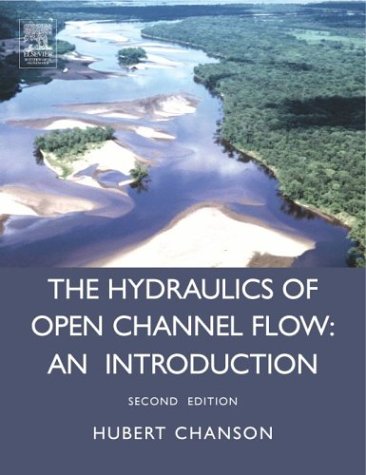
References
CHANSON, H. (1995). "Flow Characteristics of Undular Hydraulic Jumps.
Comparison with Near-Critical Flows." Report CH45/95, Dept. of Civil
Engineering, University of Queensland, Australia, June, 202 pages (ISBN 0
86776 612 3).
CHANSON, H. (1999). "The Hydraulics of Open
Channel Flows : An Introduction." Butterworth-Heinemann,
London, UK, 512 pages (ISBN 0 340 74067 1).
CHANSON, H. (2000). "Boundary Shear Stress Measurements in Undular Flows :
Application to Standing Wave Bed Forms." Water Res. Res., Vol. 36 ,
No. 10 , p. 3063 (ISSN 0043-1397). (Download PDF File)
CHANSON, H. (2002). "Hidraulica
Del
Flujo De Canales Abiertos", McGraw
Hill Interamericana, División Universidad, Columbia (ISBN:
958-410-256-7) (in Spanish).
CHANSON, H., and MONTES, J.S. (1995). "Characteristics of Undular Hydraulic
Jumps. Experimental Apparatus and Flow Patterns." Jl of Hyd. Engrg.,
ASCE, Vol. 121, No. 2, pp. 129-144 (Download
PDF file). Discussion : Vol.
123, No. 2, pp. 161-164 (ISSN 0733-9429). (Download
PDF file)
MONTES, J.S., and CHANSON, H. (1998). "Characteristics of Undular Hydraulic
Jumps. Results and Calculations." Jl of Hyd. Engrg., ASCE, Vol. 124,
No. 2, pp. 192-205 (ISSN 0733-9429). (download PDF file)
Bibliography
CHANSON, H. (1996). "Free-Surface Flows with Near-Critical Flow Conditions."
Can Jl of Civ. Eng., Vol. 23, No. 6, pp. 1272-1284 (ISSN 0315-1468).
(Download PDF
file)
CHANSON, H. (1998). "Critical Flow in Rockbed Streams with Estimated Values
for Manning's n. Comment." Geomorphology, Vol. 25, pp. 279-282 (ISSN
0169-555X). (Download PDF file)
CHANSON, H. (1999). "Critical Flow Constrains Flow Hydraulics in Mobile-Bed
Streams : a New Hypothesis - Comment." Water
Res. Res., Vol. 35, No. 3, p. 903-907 (ISSN 0043-1397). (PDF
Version at EprintsUQ)
CHANSON, H. (2001). "The Role of Environmental Fluid Mechanics in Water
System Management." Proc. 1st Intl Conf. of International Federation for
Environmental Management System IFEMS'01, Tsurugi, Japan, Keynote
lecture, T.R. NAKAGAWA Ed., IFEMS Jl, Vol. 1, pp. 1-26 (ISSN 0919-2298). (download PREPRINT)
CHANSON, H. (2001). "Flow Field in a Tidal Bore : a Physical Model." Proc.
29th IAHR Congress, Beijing, China, Theme E, Tsinghua University
Press, Beijing, G. LI Ed., pp. 365-373 (ISBN 7-302-04676-X/TV). (CD-ROM,
Tsinghua University Press, ISBN 7-900637-10-9.) (download
PDF file)
CHANSON, H. (2002). "Hydraulic Modelling of Unsteady Open Channel Flows." Lecture
Notes, Subject CIVL4120, Dept. of Civil
Engrg., Univ. of Queensland, Australia,
132 pages.
CHANSON, H. (2004). "Environmental
Hydraulics of Open Channel Flows." Elsevier-Butterworth-Heinemann,
Oxford, UK, 483 pages (ISBN 0 7506 6165 8).
CHANSON, H. (2004). "The
Hydraulics of Open Channel Flows : An Introduction." Butterworth-Heinemann, 2nd edition, Oxford,
UK, 630 pages (ISBN 0 7506 5978 5).
CHANSON, H. (2004). "Mixing and Dispersion Role of Tidal Bores." in "Fluvial,
Environmental & Coastal Developments in Hydraulic Engineering",
Balkema,
Leiden, The Netherlands, Proc. Intl Workshop on State-of-the-Art Hydraulic
Engineering, 16-19 Feb. 2004, Bari, Italy, M. MOSSA, Y. YASUDA and H.
CHANSON Ed., pp. 223-232 (ISBN 04 1535 899 X). (Download
PDF file)
CHANSON, H. (2005). "Mascaret, Aegir, Pororoca, Tidal Bore. Quid ? Où?
Quand? Comment? Pourquoi ?" Jl La Houille
Blanche, No. 3, pp. 103-114 (ISSN 0018-6368) (in French). (Download
PDF file)
CHANSON, H. (2005). "Tidal Bore Processes in the Baie du Mont Saint Michel
(France): Field Observations and Discussion." Proc.
31th Biennial IAHR Congress, Seoul, Korea, B.H. JUN, S.I. LEE, I.W.
SEO and G.W. CHOI Editors, Theme E.4, Paper 0062, pp. 4037-4046 (ISBN 89
87898 24 5). (Download PDF file)
CHANSON, H. (2008). "Turbulence in Positive Surges and Tidal Bores. Effects
of Bed Roughness and Adverse Bed Slopes." Hydraulic
Model Report No. CH68/08, Div. of Civil Engineering, The University
of Queensland, Brisbane, Australia, 121 pages & 5 movie files (ISBN
9781864999198). (PDF
file
at UQeSpace) (Movie files at UQeSpace)
CHANSON, H. (2008). "Photographic Observations of Tidal Bores (Mascarets) in
France." Hydraulic Model Report No. CH71/08, Div. of Civil Engineering, The
University of Queensland, Brisbane, Australia, 104 pages, 1 movie and 2
audio files (ISBN 9781864999303). (PDF
file at UQeSpace) (Movie
file
and sound audio files at UQeSpace)
CHANSON, H. (2009). "The Rumble Sound Generated by a Tidal Bore Event in the
Baie du Mont Saint Michel." Journal of
Acoustical Society of America, Vol. 125, No. 6, pp. 3561-3568 (DOI:
10.1121/1.3124781) (ISSN 00014966). (PDF
file) (PDF
file
at UQeSpace) Digital appendix: (.WAV
file at UQeSpace). Data set: UQeSpace
data collection.
CHANSON, H., and DOCHERTY, N.J. (2012). "Turbulent Velocity Measurements in
Open Channel Bores." European Journal of
Mechanics B/Fluids, Vol. 32, pp. 52-58 (DOI
10.1016/j.euromechflu.2011.10.001) (ISSN 0997-7546). (Postprint
at UQeSpace) (PDF
file)
CHANSON, H., REUNGOAT, D., SIMON, B., and LUBIN, P. (2011). "High-Frequency
Turbulence and Suspended Sediment Concentration Measurements in the Garonne
River Tidal Bore." Estuarine Coastal and
Shelf Science, Vol. 95, No. 2-3, pp. 298-306 (DOI
10.1016/j.ecss.2011.09.012) (ISSN 0272-7714). (PDF
file at UQeSpace) (PDF
file)
CHANSON, H., and TAN, K.K. (2011). "Turbulent Dispersion of Fish Eggs under
Tidal Bores." Fluid Dynamics &
Materials Processing, Tech Science Press, Vol. 7, No. 4, pp.
403-418 (ISSN 1555-256X (Printed); 1555-2578 (Electronic)). (Postprint at
UQeSpace) (PDF file)
DOCHERTY, N.J., and CHANSON, H. (2012). "Physical Modelling of Unsteady
Turbulence in Breaking Tidal Bores." Journal
of Hydraulic Engineering, ASCE, Vol. 138, No. 5, pp. 412-419 (DOI:
10.1061/(ASCE)HY.1943-7900.0000542) (ISSN 0733-9429). (Postprint
at UQeSpace) (PDF
file)
DONNELLY, C., and CHANSON, H. (2002). "Environmental impact of a Tidal Bore
on Tropical Rivers." Proc. 5th Intl River Management Symp.,
Brisbane, Australia, Sept., 3-6, 9 pages. (Download PDF File)
FERNANDO, R., LENG, X., and CHANSON, H. (2020). "On Unsteady Velocity
Measurements and Profiling in Compression Waves in an Asymmetrical
Trapezoidal Channel." Experimental Thermal and Fluid Science, Vol.
112, Paper 109986, 15 pages & 8 video movies (DOI:
10.1016/j.expthermflusci.2019.109986) (ISSN 0894-1777). (PDF file) (Postprint at
UQeSpace) (Video
movies at UQeSpace)
KEEVIL, C.E., CHANSON, H., and REUNGOAT, D. (2015)." Fluid Flow and Sediment
Entrainment in the Garonne River Bore and Tidal Bore Collision." Earth
Surface Processes and Landforms, Vol. 40, No. 12, pp. 1574-1586
(DOI: 10.1002/esp.3735) (ISSN 0197-9337). (PDF
file) (Preprint
at
UQeSpace)
KIRI, U., LENG, X., and CHANSON, H. (2018). "Positive Surge Propagation in a
Non-Rectangular Asymmetrical Channel." Hydraulic Model Report No.
CH110/18, School of Civil Engineering, The University of Queensland,
Brisbane, Australia, 159 pages and 2 digital appendices incl. 5 movies (ISBN
978-1-74272-196-5). (PDF
file at UQeSpace) (Digital
Appendices and Movies at UQeSpace)
KIRI, U., LENG, X., and CHANSON, H. (2020). "Positive Surge Propagating in
an Asymmetrical Canal." Journal of Hydro-environment Research, IAHR,
Vol. 31, pp. 41-47 & Supplementary material incl. 4 video movies (DOI:
10.1016/j.jher.2020.04.002) (ISSN 1570-6443). (PDF
file) (Preprint
at UQeSpace) (Movies
at UQeSpace)
KOCH, C., and CHANSON, H. (2005). "An Experimental Study of Tidal Bores and
Positive Surges: Hydrodynamics and Turbulence of the Bore Front." Report
No. CH56/05, Dept. of Civil Engineering, The University of
Queensland, Brisbane, Australia, July, 170 pages (ISBN 1864998245). (Download
PDF file) (also PDF
Version at EprintsUQ)
KOCH, C., and CHANSON, H. (2006). "Unsteady Turbulence Characteristics in an
Undular Bore." Proc. International
Conference on Fluvial Hydraulics River Flow 2006, Lisbon, Portugal,
6-8 Sept., Topic A1, R.M.L. FERREIRA, E.C.T.L. ALVES, J.G.A.B. LEAL, and
A.H. CARDOSO Eds., Balkema Publ., Taylor & Francis Group, London, Vol.
1, pp. 79-88 (ISBN 0 415 40815 6). (PDF
version at EprintsUQ) (Preprint)
KOCH, C., and CHANSON, H. (2009). "Turbulence Measurements in Positive
Surges and Bores." Journal of Hydraulic
Research, IAHR, Vol. 47, No. 1, pp. 29-40 (DOI:
10.3826/jhr.2009.2954) (ISSN 0022-1686). (PDF
file at UQeSpace)
LENG, X., and CHANSON, H. (2015). "Unsteady Turbulence during the Upstream
Propagation of Undular and Breaking Tidal Bores: an Experimental
Investigation." Hydraulic Model Report
No. CH98/15, School of Civil Engineering, The University of
Queensland, Brisbane, Australia, 235 pages & 4 video movies (ISBN 978 1
74272 135 4). (PDF
file at UQeSpace) (Video
movies at UQeSpace)
LENG, X., and CHANSON, H. (2016). "Coupling between Free-surface
Fluctuations, Velocity Fluctuations and Turbulent Reynolds Stresses during
the Upstream Propagation of Positive Surges, Bores and Compression Waves." Environmental Fluid Mechanics, Vol. 16,
No. 4, pp. 695-719 & digital appendix (DOI: 10.1007/s10652-015-9438-8)
(ISSN 1567-7419 [Print] 1573-1510 [Online]). (PDF
file) (Digital
appendix) (Reprint
at UQeSpace)
LENG, X., SIMON, B., KHEZRI, N., LUBIN, P., and CHANSON, H. (2018). "CFD
Modelling of Tidal Bores: Development and Validation Challenges." Coastal
Engineering Journal, Vol. 60, No. 4, pp. 423-436 (DOI:
10.1080/21664250.2018.1498211) (ISSN 0578-5634). (PDF
file) (Deposit
at UQeSpace)
LI, Y., and CHANSON, H. (2018). "Decelerating Bores in Channels and
Estuaries." Coastal Engineering Journal, Vol. 60, No. 4, pp. 449-465
(DOI: 10.1080/21664250.2018.1529261) (ISSN 0578-5634). (PDF
file) (Deposit
at UQeSpace)
REUNGOAT, F., CAPLAIN, B., and CHANSON, H. (2013). "Field Measurements in
the Tidal Bore of the Garonne River after a Recent Flood." Proc.
Coastal Dynamics 2013, Arcachon, France, 24-28 June, pp. 1309-1318.
(Record
at UQeSpace) (PDF file)
REUNGOAT, D., CHANSON, H., and CAPLAIN, B. (2014). "Sediment Processes and
Flow Reversal in the Undular Tidal Bore of the Garonne River (France)." Environmental Fluid Mechanics, Vol. 14,
No. 3, pp. 591–616 (DOI: 10.1007/s10652-013-9319-y) (ISSN 1567-7419 [Print]
1573-1510 [Online]). (Postprint
at UQeSpace) (PDF
file)
REUNGOAT, D., CHANSON, H., and KEEVIL, C.E, (2014). "Turbulence, Sedimentary
Processes and Tidal Bore Collision in the Arcins Channel, Garonne River
(October 2013)." Hydraulic Model Report
No. CH94/14, School of Civil Engineering, The University of
Queensland, Brisbane, Australia, 145 pages (ISBN 9781742721033). (PDF file at UQeSpace)
REUNGOAT, D., CHANSON, H., and KEEVIL, C.E. (2015). "Field Measurements of
Unsteady Turbulence in a Tidal Bore: the Garonne River in October 2013." Journal of Hydraulic Research, IAHR,
Vol. 53, No. 3, pp. 291-301 (DOI: 10.1080/00221686.2015.1021717) (ISSN
0022-1686). (Postprint
at UQeSpace) (PDF
file)
REUNGOAT, D., LENG, X., and CHANSON, H. (2016). "Hydrodynamic and
Sedimentary Processes of Tidal Bores: Arcins Channel, Garonne River in
August-September-October 2015." Hydraulic
Model Report No. CH102/16, School of Civil Engineering, The
University of Queensland, Brisbane, Australia, 270 pages (ISBN
978-1-74272-155-2). (PDF
file at UQeSpace)
REUNGOAT, D., LUBIN, P., LENG, X., and CHANSON, H. (2018). "Tidal Bore
Hydrodynamics and Sediment Processes: 2010-2016 Field Observations in
France." Coastal Engineering Journal, Vol. 60, No. 4, pp. 484-498
(DOI: 10.1080/21664250.2018.1529265) (ISSN 0578-5634). (PDF
file) (Deposit
at UQeSpace)
REUNGOAT, D., LENG, X., and CHANSON, H. (2019). "Turbulence and Suspended
Sediment Processes in the Garonne River Tidal Bore in November 2016." International
Journal of Sediment Research, IRTCES-WASER, Vol. 34, No. 5, pp.
496-508 (DOI: 10.1016/j.ijsrc.2019.03.003) (ISSN 1001-6279). (PDF file) (Postprint at
UQeSpace)
SHI, R. (2022). "Modelling Air-Water Turbulence and Properties in Unsteady
Breaking Bore." Ph.D. Thesis, The University of Queensland, School
of Civil Engineering, 286 pages (DOI: 10.14264/7f692da). (Deposit at UQeSpace)
SIMON, B., and CHANSON, H. (2013). "Turbulence Measurements in Tidal
Bore-like Positive Surges over a Rough Bed." Hydraulic
Model Report No. CH90/12, School of Civil Engineering, The
University of Queensland, Brisbane, Australia, 176 pages (ISBN
9781742720685). (PDF
file at UQeSpace)
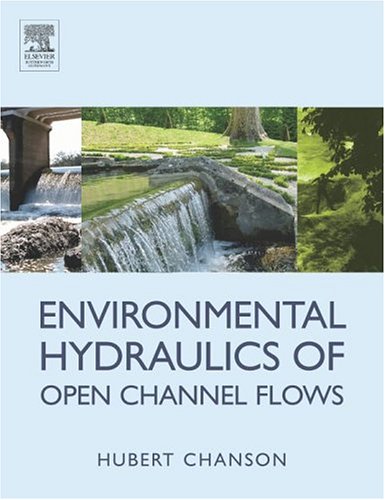 Video movie on YouTube
Video movie on YouTube
Dam break wave, Tidal bore, In-river tsunami surge: what the hell? - {https://youtu.be/SQaPoSj2lP4} (Record
at UQeSpace)
Such a bore - {https://www.youtube.com/watch?v=7mO5-wxnqTA}
Tidal Bore Research at the University of Queensland - {https://youtu.be/q1ieo7fQ6X8}
Podcast
"Tidal bores: Myths, Fables and Reality" Faculti (6:51) {https://faculti.net/tidal-bores-myths-fables-and-reality/}
Acknowledgments
The writer acknowledges the help of numerous students in this research work,
and the advice of Dr Sergio MONTES.
License

This work is licensed under a Creative
Commons Attribution-NonCommercial 3.0 Unported License.
Hubert
CHANSON is a Professor in Civil Engineering, Hydraulic Engineering
and Environmental Fluid Mechanics at the University
of Queensland, Australia. His research interests include design of
hydraulic structures, experimental investigations of two-phase flows,
applied hydrodynamics, hydraulic engineering, water quality modelling,
environmental fluid mechanics, estuarine processes and natural resources.
He has been an active consultant for both governmental agencies and
private organisations. His publication record includes over 850
international refereed papers and his work was cited over 5,500 times
(WoS) to 18,500 times (Google
Scholar) since 1990. His h-index is 39 (WoS), 43 (Scopus) and 67 (Google
Scholar), and he is ranked among the 150 most cited researchers in
civil engineering in Shanghai’s
Global Ranking of Academics. Hubert Chanson is the author of twenty
books, including "Hydraulic Design
of Stepped Cascades, Channels, Weirs and Spillways" (Pergamon,
1995), "Air Bubble Entrainment in
Free-Surface Turbulent Shear Flows" (Academic
Press, 1997), "The Hydraulics
of Open Channel Flow : An Introduction" (Butterworth-Heinemann,
1st edition 1999, 2nd
editon 2004), "The Hydraulics of
Stepped Chutes and Spillways" (Balkema,
2001), "Environmental
Hydraulics of Open Channel Flows" (Butterworth-Heinemann,
2004), "Tidal
Bores, Aegir, Eagre, Mascaret, Pororoca: Theory And Observations" (World
Scientific, 2011) and "Applied
Hydrodynamics:
an Introduction" (CRC
Press, 2014). He co-authored two further books "Fluid Mechanics for
Ecologists" (IPC Press, 2002) and "Fluid Mechanics for Ecologists.
Student Edition" (IPC, 2006). His
textbook "The Hydraulics of Open Channel Flows : An Introduction" has
already been translated into Spanish (McGraw-Hill
Interamericana) and Chinese (Hydrology Bureau of Yellow
River Conservancy Committee), and the second
edition was published in 2004. In 2003, the IAHR
presented him with the 13th Arthur Ippen Award
for outstanding achievements in hydraulic engineering. The American
Society of Civil Engineers, Environmental and Water Resources Institute
(ASCE-EWRI) presented him with the 2004 award for the Best Practice paper
in the Journal of Irrigation and Drainage Engineering ("Energy
Dissipation
and Air Entrainment in Stepped Storm Waterway" by Chanson and
Toombes 2002) and the 2018 Honorable Mention Paper Award for "Minimum Specific
Energy and Transcritical Flow in Unsteady Open-Channel Flow" by
Castro-Orgaz and Chanson (2016) in the ASCE Journal of Irrigation and
Drainage Engineering. The Institution of Civil Engineers (UK) presented
him the 2017 Baker. Medal. Hubert Chanson edited further several books : "Fluvial, Environmental and Coastal
Developments in Hydraulic Engineering" (Mossa, Yasuda & Chanson
2004, Balkema), "Hydraulics.
The
Next Wave" (Chanson & Macintosh 2004, Engineers
Australia), "Hydraulic
Structures:
a Challenge to Engineers and Researchers" (Matos & Chanson 2006,
The University of Queensland), "Experiences and
Challenges in Sewers: Measurements and Hydrodynamics" (Larrate &
Chanson 2008, The University of
Queensland), "Hydraulic
Structures:
Useful Water Harvesting Systems or Relics?" (Janssen & Chanson
2010, The University of Queensland),
"Balance
and Uncertainty: Water in a Changing World" (Valentine et al. 2011,
Engineers Australia), "Hydraulic
Structures and Society – Engineering Challenges and Extremes"
(Chanson and Toombes 2014, University
of Queensland), "Energy
Dissipation
in Hydraulic Structures" (Chanson 2015, IAHR
Monograph, CRC Press). He chaired the Organisation of the 34th
IAHR World Congress held in Brisbane, Australia between 26 June and
1 July 2011. He chaired the Scientific Committee of the 5th IAHR
International Symposium on Hydraulic Structures held in Brisbane in
June 2014. He chairs the Organisation of the 22nd Australasian Fluid
Mechanics Conference in Brisbane, Australia on 6-10 December 2020.
His Internet home page is http://www.uq.edu.au/~e2hchans.
He also developed a gallery of photographs website {http://www.uq.edu.au/~e2hchans/photo.html}
that received more than 2,000 hits per month since inception.
More pictures of tidal bore are here ...
TECHNICAL INTERNET RESOURCES
More about a history of arch dams
... More about timber crib
weirs ... More about steel
dams ...
More about engineering
failures ... More about rubber
dams ... More about a tidal
bore ...
More about the Formal Water Garden
.... More about rapid
reservoir sedimentation in Australia ...
More about Minimum Energy Loss culverts
.. More about Minimum Energy
Loss weirs ...
This page was visited : 5,250 times between
26-05-2003 and June 2012.
Last updated on 08/11/2019





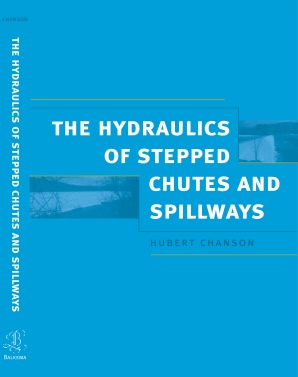
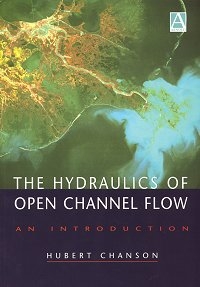
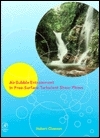
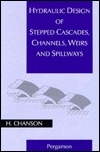
 Detailed
photographs
Detailed
photographs A hydraulic jump is a
stationary transition from a rapid (supercritical flow) to a slow flow
motion (subcritical flow). Although the hydraulic jump was described by
LEONARDO DA VINCI, the first experimental investigations were published by
Giorgio BIDONE in 1820. It is extremely turbulent and characterised by the
development of large-scale turbulence, surface waves and spray, energy
dissipation and air entrainment (e.g. CHANSON
and BRATTBERG 2000). The large-scale turbulence region is usually
called the 'roller'. Experimental observations highlight different types of
hydraulic jumps, depending upon the Froude number (footnote
(1)) of the upstream flow. An undular hydraulic jump is
observed at low Froude numbers (1< Fr <3): looking downstream (Fr=1.2)
and sideview (Fr=1.6) (CHANSON and MONTES
1995, MONTES and CHANSON 1998). With increasing Froude numbers, other types
of jumps include weak jump, oscillating jump (3.5< Fr <4.5), steady
jump and strong jump (Fr >10).
These photographs show surfers riding on a hydraulic jump roller in a river
in Munich, Germany (Photo No. 1 : flow
from right to left, Photo No. 2:
looking downstream, Courtesy of Dale YOUNG).
A hydraulic jump is a
stationary transition from a rapid (supercritical flow) to a slow flow
motion (subcritical flow). Although the hydraulic jump was described by
LEONARDO DA VINCI, the first experimental investigations were published by
Giorgio BIDONE in 1820. It is extremely turbulent and characterised by the
development of large-scale turbulence, surface waves and spray, energy
dissipation and air entrainment (e.g. CHANSON
and BRATTBERG 2000). The large-scale turbulence region is usually
called the 'roller'. Experimental observations highlight different types of
hydraulic jumps, depending upon the Froude number (footnote
(1)) of the upstream flow. An undular hydraulic jump is
observed at low Froude numbers (1< Fr <3): looking downstream (Fr=1.2)
and sideview (Fr=1.6) (CHANSON and MONTES
1995, MONTES and CHANSON 1998). With increasing Froude numbers, other types
of jumps include weak jump, oscillating jump (3.5< Fr <4.5), steady
jump and strong jump (Fr >10).
These photographs show surfers riding on a hydraulic jump roller in a river
in Munich, Germany (Photo No. 1 : flow
from right to left, Photo No. 2:
looking downstream, Courtesy of Dale YOUNG). A personal experience of
undular tidal bores
A personal experience of
undular tidal bores Basic experiments (CHANSON
1995) highlighted key features of undular flows in rectangular
channels:
Basic experiments (CHANSON
1995) highlighted key features of undular flows in rectangular
channels: Detailed
photographs
Detailed
photographs Read Coastal
Observations:
The Tidal Bore of the Sélune River, Baie du Mont Saint Michel, France
(Shore & Beach, 2004, Vol. 72,
No. 4, pp. 14-16).
Read Coastal
Observations:
The Tidal Bore of the Sélune River, Baie du Mont Saint Michel, France
(Shore & Beach, 2004, Vol. 72,
No. 4, pp. 14-16).
 Video movie on YouTube
Video movie on YouTube








